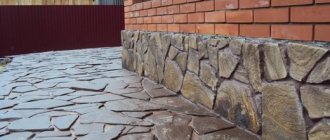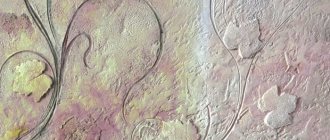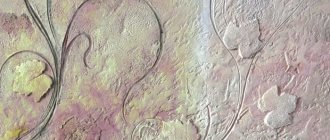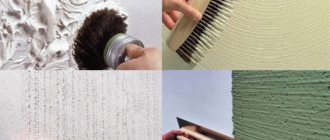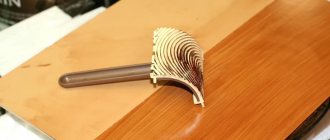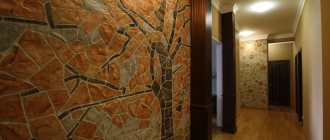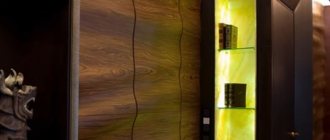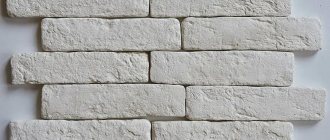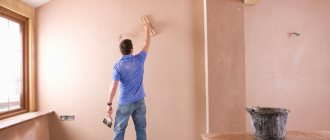Natural stone is the oldest building material, which was used by primitive tribes and legendary ancient peoples. Soon only the rich could afford beautiful and high-quality stone houses. But now everything has changed, and decorative stone has begun to be actively used in the interior. After all, outwardly it is almost indistinguishable from the real thing, but it is cheaper and easier to work with!
What it is?
In fact, decorative stone is a specific tile. It is distinguished from finishing tiles by its texture, which imitates real rocks. It is used for external and internal work, in particular in interiors.
There are several reasons for this: ease of maintenance and operation, ease of processing and installation, cost lower than that of natural granite or marble.
The material itself is lighter in weight. Dirt, grease and other stains are easily washed off from the coating. The homogeneous structure ensures high strength of the material, and the accuracy of the geometry is achieved through artificial manufacturing. Artificial stone is resistant to moisture, parasites, fungus, mold, temperature changes and other external influences.
LABRADORITE (peacock stone)
Igneous granular crystalline rock.
Color palette: usually black and gray, occasionally light. The decorative effect is given to the stone by rainbow spots on the surface of blue-green, less often golden-yellow or orange shades.
Physical properties: high strength, wear and frost resistance; water absorption no more than 0.21, density 2.71; The stone is moderately hard, brittle, highly polished, and extremely decorative.
Applications of labrodorite:
- exterior decoration of buildings
- cladding of floors, columns, wall plinths
- monumental architecture
Types of decorative stone
The properties of decorative stone depend on the material from which it is made. Be sure to take this into account when choosing, because the characteristics may vary significantly.
Decorative concrete stone
The composition includes cement, sand, plasticizers, reinforcing components, pigments and fillers. Expanded clay, pumice, and ceramic chips are most often used. This is the most common and versatile type.
Concrete is a very flexible material and a lot of impurities or additives can be introduced into it. Therefore, it allows you to create an imitation of almost any natural stone.
The finished tiles are used for wall cladding. But that's not all! Concrete is used to make sidewalk coverings, baseboards, borders, cornices and decor to look like natural wood.
Acrylic decorative stone
This is a facing material with a varied color palette, shapes and sizes. It is absolutely safe and suitable even for bathrooms and bedrooms.
Contains acrylic resins, aluminum hydroxide, pigments and fillers. This is the most repairable decorative stone. The adhesive seams are almost invisible, and the surface can be sanded perfectly.
It is almost impossible to deform acrylic stone; it does not burn and has the highest fire-resistant properties. It can be used in living rooms, bathrooms, restaurants, and medical institutions.
Decorative stone made of gypsum
It is lightweight, inexpensive, practical and accessible. It is pleasant and easy to work with, and it has been used in interiors for many years. The texture resembles sandstone, so most often decorative gypsum stone is painted to match it.
The disadvantage is that it is very sensitive to moisture. It is not recommended for use in the bathroom or kitchen, but it is absolutely environmentally friendly and breathable.
Porcelain tiles
It contains several types of clay, feldspar, minerals and pigments. The mixture is pressed and fired, so this artificial stone is stronger.
But in appearance, porcelain stoneware looks more like facing tiles than a block of natural granite. But it is resistant to temperature changes and is used in heated floors.
Quartz decorative stone
The beauty and elegance of quartz comes at a cost: it requires protection when working with it. Do not allow stone dust to enter your respiratory tract.
But the scope of application is almost unlimited: from internal and external walls to steps, stoves, swimming pools, sinks and bathtubs. Thanks to its high hygienic qualities, it can be used in public spaces: restaurants, salons, saunas.
Artificial quartz stone is not afraid of frost and does not fade. For cutting you will need diamond discs. Thanks to natural wood as a filler, this is a very durable material.
Conglomerate
At its core, it resembles quartz stone. Only chips of natural marble and granite are used for creation. And also – limestone, quartz sand, pigments.
Outwardly, it is almost impossible to distinguish it from the block of natural rock that was in the composition. But it is much lighter. It is the conglomerate that is most often used for countertops and finishing the work area.
Conglomerates
What it is? This is a type of decorative stone that is made from marble and granite chips. It is one of the durable and most reliable products that are used for interior decoration. Among other things, quartz sand, limestone chips and coloring pigments are added to the product.
Features of conglomerates:
- The appearance of the cladding is excellent. It imitates natural agglomerate and looks noble and expensive.
- It has excellent hardiness and can withstand large temperature fluctuations.
- Frost resistance is at the highest level, it does not fade under the influence of UV rays.
- It is light in weight, so this artificial stone for interior decoration can be laid independently.
Externally, the surface imitates marble, slate and granite. It will be very difficult to distinguish the products with the naked eye. Conglomerates are used to line the walls inside rooms.
Decorative stone in the hallway
Finishing with decorative stone will decorate even a small and cramped hallway. It will immediately look more comfortable and elegant, especially in light colors.
The stone decoration will be complemented by forged elements, lantern lamps, mirrors in massive antique frames.
Turquoise color in the interior: 100 photos and design ideas
Decorative stone in the kitchen
The dense, homogeneous structure, as well as high mechanical strength, make it possible to use decorative stone for cladding the work area and even for making countertops.
It does not absorb odors and stains; just wipe the stained surface with a cloth. And there are no scratches or damage from pots and pans on the countertop.
Facade cladding
In general, the same materials are used for finishing the façade as for the interior design. But there are materials that are used only for exterior decoration. One such material is sandstone. It belongs to sedimentary rocks containing quartz and calcite, which give the facade coating durability.
The warm color scheme of sandstone is simply ideal for façade design . The raw material ranges in color from white to black, with shades of red, brown and light grey. In some cases, designers skillfully vary the color palette of the facade.
Limestone is a sedimentary rock composed primarily of calcite. It has quite a variety of shades, ranging from white to brown, and even black limestone is found. The stone is subjected to mechanical stress and belongs to soft sedimentary rocks. Natural decorative material has a clean and uniform structure.
It is used not only for cladding buildings, but also for fences. Due to the inherent strength and wear resistance of limestone, it is used in the construction of steps and risers. It is used as a facing material for fireplaces. It does not lose its attractiveness and properties from environmental influences. The stone is resistant to low temperatures and has minimal thermal conductivity.
Another type of limestone is shell rock. The rock retains in its composition whole shells of mollusks and their fragments , which are connected by calcite cement . The stone shows excellent heat-saving properties, despite its natural lightness. The material is easy to saw due to its porosity. For cladding it is used not only outside, but also inside the house. It ranges in color from white and yellow to pink and dark gray.
Decorative stone in the bathroom
The bathroom is primarily about humidity and temperature fluctuations. Therefore, durable stone finishes are as common as ceramic tiles.
The stone surface is easy to clean and process. Hygiene is the most important requirement for finishing a bathroom.
Some types of artificial stone are used to make the bathtubs and sinks themselves. The material does not absorb moisture, does not mold, does not rot or peel off.
Stretch ceilings in the interior of an apartment (200 photos)
Types and features of material
Artificial and natural materials are used in different rooms, differ in price, and have different purposes.
Artificial
- Porcelain tiles are a popular type with different textures (matte, glossy, textured), resistant to temperature changes. Porcelain tiles are made from clay by pressing and firing from feldspar using different dyes.
- Brick (tile) made of concrete.
- Agglomerates. They are made from marble or granite chips with polyester resins. Not resistant to high temperatures.
- Plaster. Lightweight, cheap, and in great demand on the building materials market.
- Flexible - very similar to regular wallpaper. It consists of textiles on which sandstone is applied in a thin layer. Used for finishing hard-to-reach places, wear-resistant, vapor-permeable.
- Acrylic. It has many options and is loved by designers for its beautiful appearance.
Attention:
You can make gypsum fragments yourself using gypsum, slaked lime, dye and water.
The advantages of artificial material over natural ones are:
- light;
- repairable;
- durable enough;
- has a pleasant appearance.
Natural
Natural stone is durable. Its service life depends on extraction technologies and methods of formation.
Granite
The hardest, most durable, wear-resistant. At the same time, it is easy to process, moisture-resistant, frost-resistant, and dielectric.
The breed includes:
- feldspar;
- mica;
- quartz.
The approximate service life is from 150 years.
Marble
A commonly used rock composed of calcite and minerals . The color of marble is varied - beige, blue, gray, yellow, black and other colors. It is quite hard, moisture resistant, and environmentally friendly.
Slate
A rock consisting of medium-temperature, low-temperature minerals. In the interior, the material is coated with special varnishes.
Useful properties of slate:
- bactericidal;
- hygiene;
- moisture resistance;
- it withstands temperature changes well.
Onyx
One of the varieties of quartz. It is quite capricious in processing, but its use gives the wall a luxurious look - it seems to glow from within.
Onyx is durable and has beautiful shades:
- emerald;
- sunny amber;
- reddish brown.
Jade
Very similar to jade. The main shades are emerald, red, graphite, yellow-gray. The main properties are strength, water resistance, heat capacity.
Jadeite is produced in the form:
- bricks;
- mosaics;
- tiles
Coil
Another type of natural stone, which is produced in the form of tiles up to 2 cm thick. Very similar to jadeite, quite dense.
Dolomite
Magnesium carbonate, calcium carbonate, contains impurities of iron and clay . It can be yellow, red, white, shiny mother-of-pearl, satin, matte. It is durable, wear-resistant, environmentally friendly. It has healing properties - it calms the human nervous system.
Soapstone chlorite
One of the frequently used materials for finishing baths and saunas. Heats up quickly and maintains a constant temperature, very heat-resistant (withstands up to 1500 degrees when heated). It comes in gray-green and graphite shades.
Travertine
An economical natural stone with frost resistance, low thermal conductivity, and ease of extraction.
Primary stone colors:
- beige;
- milky white;
- pale green;
- red-red.
Although natural stone is durable, artificial stone is superior in other respects. Among the main ones:
- ease of transportation;
- safety;
- material efficiency;
- variety of colors;
- possibility of self-production;
- ease of installation.
Decorative stone in a children's room
Stone finishing fragments look perfect in themed children's rooms. For example, stylized as a castle or dungeon.
From small colorful elements you can lay out frames, mosaics and artistic panels, just like from real pebbles. You can even do this with your child - he will probably enjoy creating something with his own hands.
Photo
Stonington ResidenceRead: Paintings and posters from IKEA in the interior (100 photos)
Let's discuss this article together:
Click to cancel reply.
Decorative stone on the balcony
Resistance to external influences is especially important when cladding balconies and loggias. The material is not afraid of either frost or heat. It does not crack, swell, warp, or require regular maintenance like wood.
Decorative stone looks especially interesting in improvised winter gardens and greenhouses on the balcony.
Gray color in the interior: design ideas (100 photos)
Advantages and disadvantages
Like any other material, facing stone has its advantages and disadvantages. Among the positive characteristics of this coating are:
- Resistance to low and high temperatures.
- Long service life.
- Resistance to mechanical and atmospheric influences.
- Natural purity.
- Fire safety.
- Moisture resistant.
- Wide selection of textures, textures, colors.
The disadvantages include:
- Most often, natural materials are heavy, which negatively affects the work process. In this regard, it is necessary to carry out additional calculations and strengthen the façade or foundation of the building.
- In some cases, natural material has a significant radioactive background, which makes it impossible to use it for interior decoration.
- Many materials and installation work are unacceptable for people with average incomes.
Decorating walls with natural stone requires selecting the right raw materials. In order not to spoil the appearance of the room, it is better to use the help of specialists. When carrying out facing work, it is necessary to take into account not only the appearance of the house, but also the properties of the raw materials. Only in this case can we hope for a long service life of the material.
Decorative stone and interior styles
The use of stone finishing is not limited to one style. The wealth of textures and shades opens up endless possibilities for designers.
Classic interiors
Luxurious and elegant stone cladding is the most important attribute of pompous classics, baroque, rococo and empire. Marble of different shades is found on walls, floors, in the form of panels and inserts.
The stone texture is interestingly intertwined with modern trends in neoclassicism. She managed to get rid of excessive decorativeness and a clutter of accessories, so inserts for valuable species look even more impressive.
Decorative stone in the loft
In a rough industrial loft, stone cladding looks like home. Make it deliberately careless - choose slabs with raw texture, unevenness, and abrasions. Too neat and elegant stone decoration is inappropriate in a loft.
Decorative stone in modern style
Modernism is smooth and soft lines, natural textures, natural asymmetry, complex shades. Decorative stone is easy to process, so it can be given any desired shape.
But avoid strict rectangular plates and slabs of regular angular shape. But the mosaic, round panels, arches look like family.
Decorative stone in minimalism
Minimalism strives for simplicity, conciseness and functionality. Artificial stone is fully suitable for these tasks.
Decor in minimalism is based not on accessories, but on textures and accents - stone inserts will be such an accent. Solid finishing is rare, but several elements look impressive and will help zone the space.
Decorative stone in high-tech
High-tech tends to artificial textures and materials. But decorative stone perfectly imitates the texture of natural stone. It may seem like it doesn't belong in this style, but it doesn't!
Of all the natural materials, cold and hard stone is the easiest to fit into modern technological and futuristic styles. Give it an angular, irregular shape, choose cool black and white shades.
Decorative stone goes well with metal, glass and acrylic - typical high-tech materials.
Artificial stone for interior decoration
The price of stone produced under artificial conditions is much lower than that of the previous version. The gypsum or cement component makes it much lighter, which can significantly reduce the load on the structure of the house and such material is easier to glue. Thanks to this property, delivery and unloading becomes easier, which means the cost of the material is lower. Artificial stone deservedly leads the market of decorative building products, as it is endowed with unsurpassed qualities:
- ease of installation. It is laid with a special glue in the same way as ceramic tiles, but there is no need to carefully adjust each element, and a certain randomness only adds charm to the room;
- a huge selection of colors and textures that imitate natural minerals. There is a wide field for design ideas here;
- the coating can be repaired and restored;
- strength and durability can compete with similar qualities of natural cladding;
- Optimal hydrophobic properties make decor maintenance simple and convenient.
Artificial stone for interior decoration
There are practically no negative qualities here, except that some types of artificial coating are subject to abrasion under mechanical influence, sometimes hydrophobic treatment is indispensable and the cost may be higher than for more traditional types of finishing materials for walls (wallpaper, ceramic tiles) .
Using artificial stone for interior wall cladding
There are no strict restrictions on the use of stone in the interior, but you need to be able to stop in time so as not to overload the living space of a house or apartment with this bright and textured material. It is completely justified to decorate corners, arches and doorways with it, since here we have not only an artistic effect, but also excellent protection of vulnerable areas from mechanical damage. This technique will help highlight some interior elements and create a favorable accent on them. You can lay gypsum or any other decor with glue either over the entire selected area or in the form of small inserts.
Stone corners will favorably emphasize the zoning of space
Artificial flexible stone or gypsum products are usually glued in niches or on shelves. When decorating fireplaces, along with these types of cladding, ceramic decorative stone tiles can be used for interior decoration.
Thanks to the environmental friendliness of artificial decor, it can be glued to the headboard of bedrooms, which looks very original. In living rooms, TVs are hung on tiled wall surfaces, and the stone does not have to have a linear layout - it can be positioned randomly.
With the advent of a new product on the construction market, such as flexible stone, radial cladding of niches and ceilings is now much easier to carry out due to the pliability of the material. In general, a flexible artificial mineral deserves special attention, and we will definitely tell you more about it.
Laying decorative stone
Covering surfaces with decorative stone is almost no different from laying tiles. You will need cement mortar or glue, a level, and spatulas. The stone is laid only on a flat base. To do this, use plaster or drywall. Large differences in level will help to hide the profile design.
Seal all seams and joints. Apply several layers of plaster, sand each of them with sandpaper. Clean the surface from dust, use a primer or primer to improve adhesion.
Apply a small layer of the adhesive mixture directly to the surface and leave for a few seconds. Apply another thin layer of mortar to the inside of the stone slab. Lay the stone on the base - the slabs are laid closely, with cross dividers.
After the mixture has set, seal the seams and minor defects with decorative putty. To add shine to the surface of the decorative stone, use a special varnish.
Price of facing stone
If you compare prices for facing stone , then natural is always more expensive than artificial. The cost of sandstone will be 100-200 rubles per square meter. Depending on the density, limestone will cost from 800 rubles to 2-3 thousand rubles per square meter. m.
Granite blocks will cost from 1 thousand rubles per square meter and above. Marble blocks will cost from 10 thousand rubles per sq. m. m. The price of slate will start from 500 rubles per square meter and above.
Cladding with decorative stone with or without jointing will cost from 600 rubles to 1.5 thousand rubles per square meter. The cladding method called “imitation brickwork” will cost from 650 rubles to 1.6 thousand rubles per sq. m. m.
Cladding with architectural elements will cost between 1100 and 1500 rubles per sq. m. m. The price is indicated only for stone laying work. Additional work such as installing metal mesh, priming, plastering and insulation are considered separately.
Cladding with natural or decorative stone is considered an exclusive work. Everything will depend on the specialist’s skill, experience, skills, imagination and creativity.
Not only tools play an important role, but also connecting elements such as glue, mortar or varnish. The specialist must do the job perfectly, without damaging a single element, especially when working with materials such as granite or marble.
Decorative stone in the interior - photo
The scope of application of decorative stone in interior design and decoration is almost limitless. Therefore, feel free to fantasize and experiment for your own pleasure. And for your inspiration, we have put together this photo selection!
Did you like the post? Subscribe to our channel in Yandex.Zen, it really helps us in our development!
Painting nuances
Different coloring agents are used for different types of stone. This can be varnish, water-based paint, special impregnation or glaze.
- To make the color more saturated, it is necessary to apply several layers of dye.
- To give the gypsum stone a snow-white color, it is enough to coat it with varnish once.
- Oil and acrylic based paints should not be used for decorative stone.
To highlight several stones in different colors, nearby stones are sealed with masking tape.
